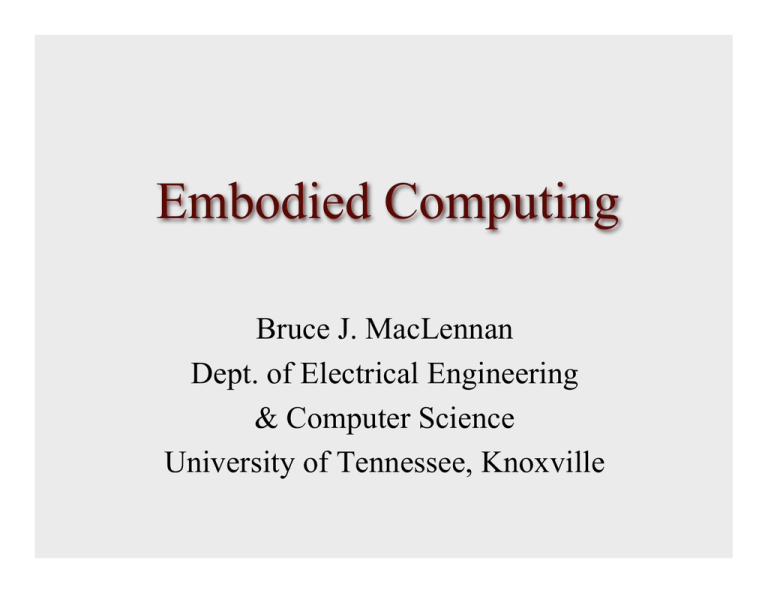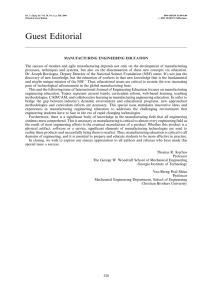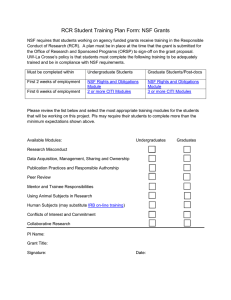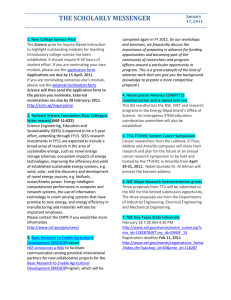Embodied Computing
advertisement

Embodied Computing Bruce J. MacLennan Dept. of Electrical Engineering & Computer Science University of Tennessee, Knoxville Outline • Recent Research – Molecular combinatory computing – Generalized computation & the U-machine – Artificial morphogenesis • New Directions – – – – Convergence of scales Novel characteristics Need for new models of computation Embodied computing 20 February 2008 NSF Workshop: Biological Communications Technology 2 Central Themes • Computation and physics – novel computational models to exploit novel technologies – computational control of matter formal material • Natural computation – computation occurring in nature, or – inspired by that occurring in nature 20 February 2008 NSF Workshop: Biological Communications Technology 3 Current Research in Embodied Computing • Molecular Combinatory Computing • Generalized Computation • Artificial Morphogenesis 20 February 2008 NSF Workshop: Biological Communications Technology 4 Molecular Combinatory Computing for Nanostructure Synthesis & Control Supported by NSF Nanoscale Exploratory Research Grant 20 February 2008 NSF Workshop: Biological Communications Technology 5 Molecular Combinatory Computing • Systematic approach to nanotechnology based on small set of molecular building blocks • Combinatory logic • Computational universality from two substitutions (+ a few more) • Substitutions may be done in any order or in parallel 20 February 2008 NSF Workshop: Biological Communications Technology 6 K-Substitution ((K X) Y) X 20 February 2008 NSF Workshop: Biological Communications Technology 7 S-Substitutions (((S X) Y) Z) ((X Z) (Y Z)) 20 February 2008 NSF Workshop: Biological Communications Technology 8 -Substitution ( F) y(1) 20 February 2008 where y (F y(0)) NSF Workshop: Biological Communications Technology 9 Example of Simple Computation ((S(KS)K)S) (((KS)S)(KS)) 20 February 2008 NSF Workshop: Biological Communications Technology 10 Example of Simple Computation ((KS)S) S 20 February 2008 NSF Workshop: Biological Communications Technology 11 Example of Simple Computation (((S(KS)K)K) (((KS)K)(KK)) 20 February 2008 NSF Workshop: Biological Communications Technology 12 Example of Simple Computation ((KS)K) S 20 February 2008 NSF Workshop: Biological Communications Technology 13 Example of Simple Computation result = (S(KK)) 20 February 2008 NSF Workshop: Biological Communications Technology 14 Example: Nanotube Visualization of nanotube produced by ptube5,4 20 February 2008 NSF Workshop: Biological Communications Technology 15 Example: Nanotube 20 February 2008 NSF Workshop: Biological Communications Technology 16 In Functional Programming Language let prib(m) = compose (polyextend shared-formalize m) rib where rib = polyextend compose m cycle (reduce permute m identity) in let ptube(m, n) = iterate n prib(m) in ptube(5, 4) 20 February 2008 NSF Workshop: Biological Communications Technology 17 Reduced to SKY Tree (((S ((S (K S)) K)) ((S ((S (K S)) K)) ((S ((S (K S)) K)) ((S ((S (K S)) K)) (K ((S K) K)))))) ((((S ((((S (K S)) K) ((S (K S)) K)) S)) (K K)) ((((S (K S)) K) S) (((S (K S)) K) ((((S (K S)) K) S) (((S (K S)) K) ((((S (K S)) K) S) (((S (K S)) K) ((((S (K S)) K) S) (((S (K S)) K) S))))))))) ((((((S (K S)) K) ((S (K S)) K)) ((((S (K S)) K) ((S (K S)) K)) ((((S (K S)) K) ((S (K S)) K)) ((((S (K S)) K) ((S (K S)) K)) ((S (K S)) K))))) Y) (((((S (K S)) K) (((S (K S)) K) ((((S (K S)) K) (((S (K S)) K) ((((S (K S)) K) (((S (K S)) K) ((((S (K S)) K) (((S (K S)) K) ((S ((((S (K S)) K) ((S (K S)) K)) S)) (K K)))) ((S ((((S (K S)) K) ((S (K S)) K)) S)) (K K))))) ((S ((((S (K S)) K) ((S (K S)) K)) S)) (K K))))) ((S ((((S (K S)) K) ((S (K S)) K)) S)) (K K))))) ((S ((((S (K S)) K) ((S (K S)) K)) S)) (K K))) ((S K) K))))) 20 February 2008 NSF Workshop: Biological Communications Technology 18 Linearized for Chemical Synthesis & Replication PPPS PPS PK SQQ KQQ PPS PPS PK SQQ KQQ PPS PPS PK SQQ KQQ PPS PPS PK SQQ KQQ PK PPS KQ KQQQQQQ PPPPS PPPPS PK SQQ KQ PPS PK SQQ KQQ SQQ PK KQQ PPPPS PK SQQ KQ SQ PPPS PK SQQ KQ PPPPS PK SQQ KQ SQ PPPS PK SQQ KQ PPPPS PK SQQ KQ SQ PPPS PK SQQ KQ PPPPS PK SQQ KQ SQ PPPS PK SQQ KQ SQQQQQQQQQ PPPPPPS PK SQQ KQ PPS PK SQQ KQQ PPPPS PK SQQ KQ PPS PK SQQ KQQ PPPPS PK SQQ KQ PPS PK SQQ KQQ PPPPS PK SQQ KQ PPS PK SQQ KQQ PPS PK SQQ KQQQQQ YQ PPPPPS PK SQQ KQ PPPS PK SQQ KQ PPPPS PK SQQ KQ PPPS PK SQQ KQ PPPPS PK SQQ KQ PPPS PK SQQ KQ PPPPS PK SQQ KQ PPPS PK SQQ KQ PPS PPPPS PK SQQ KQ PPS PK SQQ KQQ SQQ PK KQQQQ PPS PPPPS PK SQQ KQ PPS PK SQQ KQQ SQQ PK KQQQQQ PPS PPPPS PK SQQ KQ PPS PK SQQ KQQ SQQ PK KQQQQQ PPS PPPPS PK SQQ KQ PPS PK SQQ KQQ SQQ PK KQQQQQ PPS PPPPS PK SQQ KQ PPS PK SQQ KQQ SQQ PK KQQQ PPS KQ KQQQQQ 20 February 2008 NSF Workshop: Biological Communications Technology 19 Molecular Computation 20 February 2008 NSF Workshop: Biological Communications Technology 20 Hexagonal Membrane Produced by hgridt2,3 N Arown = BW[n-1]°B[n] Vrown = W[n]°KI°K(2n-2)° B[n-1]°C[n]IN°CIN drowtn = Vrowtn°Arown hgridtm,n = Zn-1W(ZmdrowtnN) 20 February 2008 NSF Workshop: Biological Communications Technology 21 Possible Molecular Implementation • Covalently-structured molecular building blocks for nodes and linking groups • H-bonds for interconnections • H-bonds for identification • Synthetic components appended • Substitutions controlled by enzyme-like covalently-structured molecules 20 February 2008 NSF Workshop: Biological Communications Technology 22 Progress to Date • Simulation & theoretical studies: – ways of assembling hierarchical heterogeneous structures from patches – membranes, pores, sensor interface, one-shot channels, simple actuators, nanotubes • In progress: – recyclable channels, cilia, rotary motion – molecular implementations (including DNA) 20 February 2008 NSF Workshop: Biological Communications Technology 23 Pros and Cons • Pros – Turing-universal – substitutions can be done in any order or in parallel • Cons – not fault- or error-tolerant – computational universality does not imply synthetic/behavioral universality – requires aqueous medium 20 February 2008 NSF Workshop: Biological Communications Technology 24 Summary of MCC • Concept of molecular combinatory computing – molecular networks self-organize by simple substitution reactions – computationally universal • Simulated synthesis applications • Synthesis of large, heterogeneous structures • Possible molecular implementation based on Hbonded, covalently-structured building blocks 20 February 2008 NSF Workshop: Biological Communications Technology 25 Generalized Computation and the U-Machine 20 February 2008 NSF Workshop: Biological Communications Technology 26 Computation in General Sense • A definition applicable to computation in nature as well as in computers • Computation is a physical process, the purpose of which is abstract operation on abstract objects • A computation must be implemented by some physical system, but it may be implemented by any physical system with the appropriate abstract structure 20 February 2008 NSF Workshop: Biological Communications Technology 27 Abstract Spaces • Should be general enough to include continuous & discrete spaces • Hypothesis: separable metric spaces • Include continua & countable discrete spaces • separable approximating sequences 20 February 2008 NSF Workshop: Biological Communications Technology 28 The U-Machine • Goal: a model of computation over abstract spaces that can be implemented in a variety of physical media • In particular, bulk nanostructured materials in which: – access to interior is limited – detailed control of structure is difficult – structural defects and other imperfections are unavoidable 20 February 2008 NSF Workshop: Biological Communications Technology 29 Urysohn Embedding 20 February 2008 NSF Workshop: Biological Communications Technology 30 Computation in Hilbert Space ( X,X ) (Y,Y ) U W V f g Q Q p( l ) [0,1] (Z,Z ) l 20 February 2008 Q p( m ) fˆ [0,1] m NSF Workshop: Biological Communications Technology p( n ) gˆ [0,1] n 31 Overall Structure • Variable (data) space – Large number of scalar variables for Hilbert coefficients – Partitioned into regions representing abstract spaces • Function (program) space – Flexible interconnection ( 3D) – Programmable linear combinations – Application of basis functions 20 February 2008 NSF Workshop: Biological Communications Technology 32 Depiction of UM Interior • Shell contains variable areas & computational elements • Interior filled with solid or liquid matrix (not shown) • Paths formed through or from matrix 20 February 2008 NSF Workshop: Biological Communications Technology 33 Layers in Data Space • Connection matrix has programmable weights • Linear combinations are inputs to nonlinear basis functions • Exterior access to both sides for programming 20 February 2008 NSF Workshop: Biological Communications Technology 34 Depiction of UM Exterior 20 February 2008 NSF Workshop: Biological Communications Technology 35 Diffusion-Based Path Routing 20 February 2008 NSF Workshop: Biological Communications Technology 36 Example of Path Routing • Starts and ends chosen randomly • Quiescent interval (for attractant decay) omitted from video • Each path occupies ~0.1% of space • Total: ~4% 20 February 2008 NSF Workshop: Biological Communications Technology 37 Front 20 February 2008 NSF Workshop: Biological Communications Technology 38 Remarks • More realistic procedure: – Systematic placement of regions – Order of path growth – Control of diffusion & growth phases • General approach is robust (many variations work about as well) • Paths could be formed by: – Migration of molecules etc. – Change of state of immobile molecules 20 February 2008 NSF Workshop: Biological Communications Technology 39 Example Connection-Growth Process • Goal: approximately full interconnection between incoming “axons” (A) and “dendrites” (D) of basis functions – Doesn’t have to be perfect • Each A & D periodically initiates fiber growth – Growth is approximately away from source • Fibers repel others of same kind – Diffusible, degradable repellant – Fibers follow decreasing gradient (in XZ plane) • Contact formed when A and D fibers meet 20 February 2008 NSF Workshop: Biological Communications Technology 40 Example of Connection Formation • 10 random “axons” (red) and “dendrites” (blue) • Simulation stopped after 100 connections (yellow) formed 20 February 2008 NSF Workshop: Biological Communications Technology 41 Resulting Connections 20 February 2008 NSF Workshop: Biological Communications Technology 42 Summary of U-Machine • Permits computation on quite general abstract spaces (separable metric spaces) – Includes analog & digital computation • Computation by linear combinations & simple nonlinear basis functions • Simple computational medium can be reconfigured for different computations • Potentially implementable in a variety of materials 20 February 2008 NSF Workshop: Biological Communications Technology 43 Programmable Microorganisms for Artificial Morphogenesis Artificial Morphogenesis 20 February 2008 • Based on models of embryological development • Cells migrate by local interaction & chemical signals • Possible implementation: “programmable” micro-organisms • But there may be others NSF Workshop: Biological Communications Technology 45 Multiscale Assembly • Assembly from nanoscale to macroscale • Macroscopic test cases (“killer apps”?): – – – – – – – multilayer tissues tubes articulated structures periodic structures branching structures bristles somatic regions 20 February 2008 NSF Workshop: Biological Communications Technology 46 Some Primitives • Cellular / discrete – – – – translation/rotation adhesion/release conformal change differentiation/state change – collision/interaction – proliferation/apoptosis 20 February 2008 • Continuum – – – – – elasticity diffusion degradation fluid flow gradient ascent NSF Workshop: Biological Communications Technology 47 Programmed Morphogenesis • Libraries of operations – – – – – – – diffusion degradation gradient ascent activation-inhibition proliferation/apoptosis elasticity etc. • Coordinated algorithms 20 February 2008 NSF Workshop: Biological Communications Technology 48 Why Micro-Organisms? • Micro-organisms can be viewed a micro-robots with capabilities for: – – – – – – – – – locomotion sensing control simple (low-precision analog) computation assembly collective, coordinated behavior reproduction self-defense metabolism (matter/energy acquisition, growth, repair) • Can be genetically-engineered for our purposes 20 February 2008 NSF Workshop: Biological Communications Technology 49 The Programmable Microorganism (“Promorg”) • Noncoding DNA can be used for “genetic circuits” – in eukaryotes, 10–70% – equivalent of about 3000 genes in yeast • Equipped with an assortment of generally useful sensors & effectors (especially for selforganization) • Special-purpose modifications for particular applications • Research: principles of design & self-organization 20 February 2008 NSF Workshop: Biological Communications Technology 50 Tentative Capabilities • Neutral proteins for programmable control – gene regulatory & coding sequences – connections can be regulated by external signals • Membrane & cytoplasm receptors for: – chemical signals – light, etc. • Effectors – – – – cilia for locomotion cell adhesion exocytosis programmed cell death 20 February 2008 NSF Workshop: Biological Communications Technology 51 New Directions 20 February 2008 NSF Workshop: Biological Communications Technology 52 Convergence of Scales tim e space computation physical realization 20 February 2008 new technologies Increasing speed and density will require computational processes to be more similar to their physical realizations NSF Workshop: Biological Communications Technology 53 Novel Characteristics • • • • • Continuous Nondeterministic Asynchronous parallel Reversible Nonequilibrium system • • • • Stationary states Spatial factors Quantum phenomena General-purpose primitives • Moving more rather than less Goal: Exploit rather than circumvent 20 February 2008 NSF Workshop: Biological Communications Technology 54 Need for New Models of Computation • Historical importance of Boolean logic • Importance of technology-independent models – independent of specific implementation – generically implementable • What is the essence of computing? 20 February 2008 NSF Workshop: Biological Communications Technology 55 Some Principles of Adaptive Self-Organization • Positive & negative feedback • Noise, randomness, imperfection • Amplification of random fluctuations • Symmetry breaking • Diffusion • Stigmergy • Simple, local microdecisions 20 February 2008 • • • • • • Multiple interactions Circular causality Excitable media Local nonlinear interactions Adaptive stationary states Nonconvergence, diversity & suboptimal solutions • Developmental cascades • Entrainment & distributed synchronization NSF Workshop: Biological Communications Technology 56 Embodied Computing • From embedded computing to embodied computing • embodiment = “the interplay of information and physical processes” — Pfeiffer, Lungarella & Iida (Science 318, 1088) 20 February 2008 NSF Workshop: Biological Communications Technology 57 Concept • Offline computing – input—process—output – computing is abstract (generically realized) • Embedded computing – sensor—processor—actuator – sensors/actuators interface to physical world – computing is still abstract • Embodied computing – computation is a physical system among physical systems 20 February 2008 NSF Workshop: Biological Communications Technology 58 Challenges • Less idealized, less independent of physical realization • Physical processes cannot be ignored while designing information processes • Physical morphology, power, etc. are critical • Previously discussed Novel Characteristics • Multiscale structural assembly • General-purpose computing? Universality? 20 February 2008 NSF Workshop: Biological Communications Technology 59 Approach • Look for common physical processes & view as information processes – especially biological processes • Determine how they exploit physical realization & physical environment • Determine how generic they are • Characterize in general terms for multiple instantiation 20 February 2008 NSF Workshop: Biological Communications Technology 60 Benefits • Information may be implicit in physical representation & environment • Many information processes come for free • Examples: – – – – diffusion saturation/depletion decay symmetry breaking 20 February 2008 NSF Workshop: Biological Communications Technology 61 Conclusions • Embodied computation is inherently physical • This presents challenges • But also many opportunities • Nature provides many useful examples 20 February 2008 NSF Workshop: Biological Communications Technology 62 Some Resources 1. 2. 3. 4. 5. 6. 7. 8. 9. Anderson, M.L. (2003), Embodied cognition: A field guide, Artif. Intell. 149: 91–130. Hamann, H., & Wörn, H. (2007), Embodied computation, Par. Proc. Ltrs. 17 (3): 287–98. MacLennan, B.J. (2003), Transcending Turing computability, Minds & Machines 13 (1): 3–22. MacLennan, B.J. (2004), Natural computation and non-Turing models of computation, Theor. Comp. Sci. 317: 115–145. MacLennan, B.J. (in press), Super-Turing or non-Turing? Extending the concept of computation, Int’l Journ. Unconvent. Computing. Pfeifer, R., Lungarella, M., & Iida , F. (2007), Self-organization, embodiment, and biologically inspired robotics, Science 318: 1088–93. Pfeifer, R., & Bongard, J.C. (2007), How the body shapes the way we think — A new view of intelligence, MIT. Stepney, S. (2004), Journeys in non-classical computation, Grand Challenges in Comp. Res., ed. Hoare & Milner, BCS, 29–32. Stepney, S. (in press), The neglected pillar of material computation, Physica D. 20 February 2008 NSF Workshop: Biological Communications Technology 63







